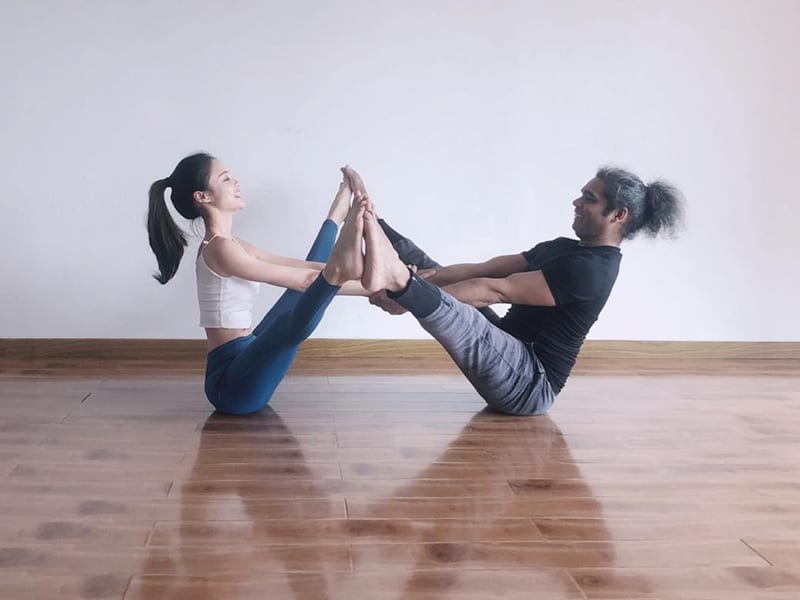A woman’s life postpartum is a hectic mess. Whether she is working or not, her life turns a full 360 degrees with the arrival of a child. Lunch is eaten in instalments, laundry happens once a week, and sticking to a workout schedule or having one at all can become impossible.
So how can mothers indulge in a fitness routine while caring for their children? The best solution is to simply make it an activity you can do together.
A proponent of yoga and the founder of Sohan Yoga International, expert Sohan Singh shares how you can start practising yoga with your toddlers and kids, ways to make the activity safe, and asanas that make exercising fun for both you and the child.
1. From what age can you start mommy-baby yoga?
Gentle yoga can be performed at any age. For newborn babies, minor stretching and movement of the arms and legs are beneficial. I usually recommend asanas like the Apana-Asana (Knee-to-Chest Pose) for newborn babies.
When it comes to performing Mommy-Baby yoga, a lot of yoga studios welcome babies within their third week. But personally, I recommend that the baby be old enough to be able to hold its own head without support. So mostly when the baby is at least 3 months old, that is when the child is aware of its body. Performing yoga in the third month is safer.
2. Is it safe? What are the benefits of mommy-baby yoga?
Mommy-baby yoga is completely safe but, in the presence of a trained yoga instructor. I also recommend, to most mommy-baby clients of mine, to take approval from their child’s paediatrician as well as their own doctor before attempting any baby yoga.
There are plenty of benefits for mom and child:
- Improved digestion
- Develops motor and sensory skills in the babies
- Promotes better sleep
- Improves blood flow and opens-up the body
- Helps ease new parent jitters
- It helps you and your new baby bond
5 Asanas You Can Do With Your Baby Or Toddler
1. Good Morning Stretch
2. Wind-Relieving Pose (Pavana Mukta-Asana)
3. Knee-To-Chest Pose (Apana-Asana)
4. Cobbler’s Pose (Baddha Koṇā-Asana)
5. Tree Pose (Vriksha-Asana)
5 Asanas You Can Do With Your Grown-up Child (5-13 Years)
1. Boat Pose (Paripurna Nava-Asana)

- Position yourself with your knees bent and far apart, your feet flat on the ground, your toes brushing your child’s.
- Before doing anything–visualise this: You’ll be taking Happy Baby Pose, sitting upwards, pressing your feet into your child’s, then straightening the legs.
- Reach between your legs to grab onto the hands of your child.
- Lean back to lift both feet off the mat, taking your legs into an angle of approximately 90 degrees, so you can press the sole of your feet into your child’s soles.
- Engage the stabilising heart as you straighten your legs into a straddle.
2. Downward-Facing Dog (Adho-Mukhasvana-Asana)
- Come onto your fours. It should look like a tabletop posture.
- With exhalation lift your hip up, straightening the knees and elbows, form an inverted V-shape with the body.
- Give a good stretch across your shoulder and try to push your heels on the ground and feel the stretch on calf muscles.
- Continue to breathe normally and hold the posture for 30 seconds or till you are comfortable.
- With an exhalation, put your knees down and relax in Balasana.
3. Cat Pose (Marjaria-Asana)
- Kneel on the mat with your wrists under your shoulders and knees under your hips.
- Exhale while you try to make an arch with your back and belly while looking down at the mat. The posture should resemble a cat stretching.
- Inhale and repeat the cow pose followed by exhalation into the cat pose.
- Repeat these poses alternatively for 5-10 times.
4. Cobra Pose (Bhujanga-Asana)
- Lie down on your stomach. Rest your toes on the mat with your heels facing the sky.
- Place your hands parallel to your shoulders, keeping your shoulders bent.
- While inhaling, straighten your arms and push your upper body away from the mat.
- Try to go as high as possible while keeping your pelvis and feet firmly on the mat.
- Hold the pose for 30 seconds.
- Come back to a neutral position as your exhale.
5. Corpse Pose (Shava-Asana)
- Lie on your back with your legs spread out.
- Keep your hands on the sides with palms facing the sky.
- While staying in this relaxing pose, breathe deeply.
- Take time to focus your attention on each part of the body.
- Stay in the pose for up to 5 minutes.
Precautionary Tips & Measures
- The doctor’s approval is a must.
- Do not engage in any poses that involve working-up the core.
- Do not stretch too much. After birth, the ligaments and muscles are still very fragile.
- The baby comes first. Don’t exert the little one’s muscles. The baby’s body is very fragile.
- It is safer to know beforehand if the baby can carry its head on its own. If not, don’t perform the asanas.